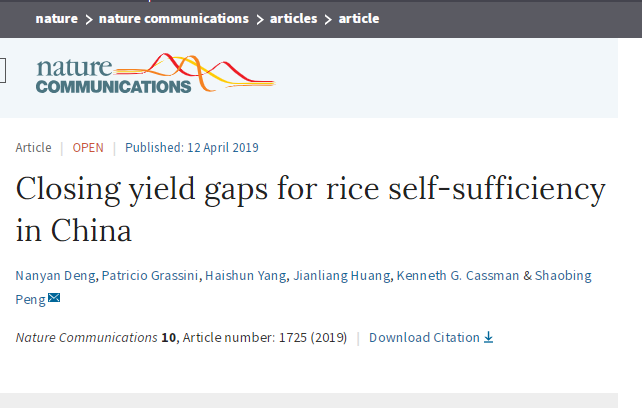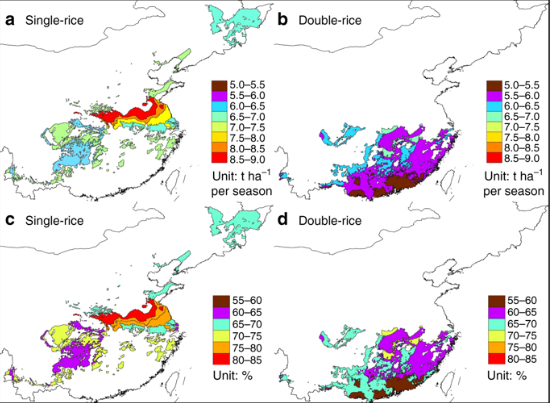

On April 12, Nature Communications published an online article entitled “Closing yield gaps for rice self-sufficiency in China” by Professor Peng Shaobing’s research team, National Key Laboratory of Crop Genetic Improvement, HZAU. This article scientifically, comprehensively and systematically evaluates the rice yield gap at the national scale, explores the effective ways to ensure the steady increase of China’s total rice yield, and puts forward some suggestions for the sustainable development of China's rice production in the future.
Crop yield gaps refer to the difference between the potential yield of crops and the actual yield by farmers under specific ecological climate, which can effectively reflect the current crop production and potential growth. More than 450 million mu of rice crop is planted annually in China (18% of global sown area) and about 210 million tons of rice is produced (28% of global rice output). It provides staple food for more than 65% of China’s population and basic guarantee of the self-sufficiency in rice supply. With the growing population, China’s demand for rice will further increase in the future. However, land resources restrict the expansion of rice planting area, meanwhile water and fertilizer and other resources restrict the improvement of rice yield per unit area. The shortage of rural labor and the increase of production costs pose a serious challenge to increasing rice yield and efficiency. Therefore, here come the questions that how to ensure global food security in the future and how to deal with the impact of future environmental changes on rice production. To this end, Professor Peng Shaobing’s team has conducted a long-term and in-depth research with scholars from University of Nebraska-Lincoln.
China covers a large rice planting area, with great differences in growth environment, complex cropping patterns and multiple crop types. Hence, it is of great significance to evaluate the crop yield gaps at the national scale in a scientific and objective way. Based on the Agricultural Climate Zone, this research employs Global Yield Gap Atlas (GYGA), upgrading a total of 875 meteorological stations in the whole country to 50 representative buffer zones (covering 86% of the national rice harvest area). The latest international rice growth model is used to simulate the spatiotemporal change of yield potential of various rice planting patterns in different regions, and the relevant statistics are used to estimate the yield gaps. Then, the bottom-up scaling methods are used to assess the yield gaps in agro-climatic zones, provinces, and at national levels, analyzing the balance of supply and demand of rice in China in 2030. It is found that the current national average yield gap account for 31% of potential production. With the guarantee of maintaining cropping land, through the improvement of varieties and cultivation techniques, the annual growth rate of rice yield will be kept the same as that of the past 30 years to reduce the yield gap. In 2030, China can basically achieve self-sufficiency in rice supply. In addition, the yield gap of double cropping rice is 6% higher than that of single cropping rice, showing a larger potential for increasing yield, which can be used as a selective strategy to adjust the planting structure to improve the total yield when the supply and demand for rice is imbalanced.
Professor Peng Shaobing is the corresponding author of this article, and postdoctoral researcher Deng Nanyan is the first author. This research was jointly completed by Huazhong Agricultural University and University of Nebraska–Lincoln (U.S.). It was supported by the earmarked fund for the National Key Research and Development Program of China, China Agriculture Research System, the Program of Introducing Talents of Discipline to Universities in China, the Program for Changjiang Scholars and Innovative Research Team in University of Ministry of Education of China, and the Daugherty Water for Food Global Institute at University of Nebraska-Lincoln.
Link of the article:
https://www.nature.com/articles/s41467-019-09447-9
Source: http://news.hzau.edu.cn/2019/0412/53855.shtml
Translated by: Zhao Dongli
Supervised by: Pan Buhan